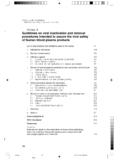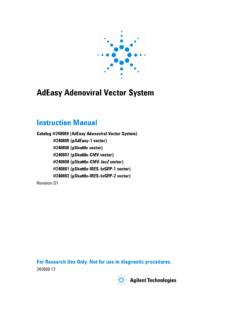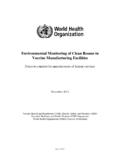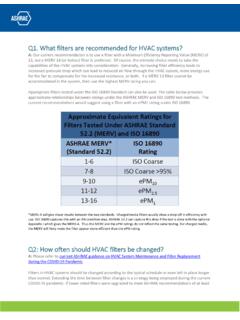Transcription of October 1997 CPMP/ICH/295/95 - European Medicines Agency
1 European Medicines Agency 7 Westferry Circus, Canary Wharf, London, E14 4HB, UK Tel. (44-20) 74 18 85 75 Fax (44-20) 75 23 70 40 E-mail: EMEA 2006 Reproduction and/or distribution of this document is authorised for non commercial purposes only provided the EMEA is acknowledged October 1997 CPMP/ICH/295/95 ICH Topic Q 5 A (R1) Quality of Biotechnological Products: viral Safety Evaluation of Biotechnology Products Derived from Cell Lines of Human or Animal Origin Step 5 NOTE FOR GUIDANCE ON QUALITY OF BIOTECHNOLOGICAL PRODUCTS: viral SAFETY EVALUATION OF BIOTECHNOLOGY PRODUCTS DERIVED FROM CELL LINES OF HUMAN OR ANIMAL ORIGIN ( CPMP/ICH/295/95 ) TRANSMISSION TO CPMP December 1995 TRANSMISSION TO INTERESTED PARTIES December 1995 COMMENTS REQUESTED BEFORE June 1996 FINAL APPROVAL BY CPMP April 1997 DATE FOR COMING INTO OPERATION October 1997 EMEA 2006 2 viral SAFETY EVALUATION OF BIOTECHNOLOGY PRODUCTS DERIVED FROM CELL LINES OF HUMAN OR ANIMAL ORIGIN ICH Harmonised Tripartite Guideline Table of Contents 1.
2 INTRODUCTION 4 2. POTENTIAL SOURCES OF VIRUS CONTAMINATION 5 Viruses That Could Occur in the Master Cell Bank (MCB) 5 Adventitious Viruses That Could Be Introduced During Production 5 3. CELL LINE QUALIFICATION: TESTING FOR VIRUSES 5 Suggested Virus Tests for MCB, Working Cell Bank (WCB) and Cells at the Limit of in vitro Cell Age Used for Production 5 Master Cell Bank 5 Working Cell Bank 6 Cells at the Limit of in vitro Cell Age Used for Production 6 Recommended viral Detection and Identification Assays 6 Tests for Retroviruses 6 In vitro Assays 7 In vivo Assays 7 Antibody Production Tests 7 Acceptability of Cell Lines 7 4. TESTING FOR VIRUSES IN UNPROCESSED BULK 7 5. RATIONALE AND ACTION PLAN FOR viral CLEARANCE STUDIES AND VIRUS TESTS ON PURIFIED BULK 8 6. EVALUATION AND CHARACTERISATION OF viral CLEARANCE PROCEDURES 9 The Choice of Viruses for the Evaluation and Characterisation of viral Clearance 10 "Relevant" viruses and "Model" viruses 10 Other considerations 11 Design and Implications of viral Clearance Evaluation and Characterisation Studies 11 Facility and staff 11 Scaled-down production system 11 Analysis of step-wise elimination of virus 12 Determining physical removal versus inactivation 12 inactivation assessment 12 Function and regeneration of columns 13 Specific precautions 13 Interpretation of viral Clearance Studies 13 Limitations of viral Clearance Studies 14 EMEA 2006 3 Statistics 15 Re-Evaluation of viral Clearance 15 7.
3 SUMMARY 15 GLOSSARY 17 Table 1: Virus Tests to Be Performed Once at Various Cell Levels 19 Table 2: Examples of the Use and Limitations of Assays Which May Be Used to Test For Virus 20 Table 3: Virus Detected in Antibody Production Tests 21 Table 4: Action Plan for Process Evaluation of viral Clearance and Virus Tests on products 22 APPENDIX 1: PRODUCTS DERIVED FROM CHARACTERISED CELL BANKS WHICH WERE SUBSEQUENTLY GROWN IN VIVO 23 APPENDIX 2: THE CHOICE OF VIRUSES FOR viral CLEARANCE STUDIES 24 Table A-1: Examples of Viruses Which Have Been Used in Virus Clearance Evaluation Studies 25 APPENDIX 3: STATISTICAL CONSIDERATIONS FOR ASSESSING VIRUS ASSAYS 26 PROBABILITY OF DETECTION OF VIRUSES AT LOW CONCENTRATIONS 26 APPENDIX 4: CALCULATION OF REDUCTION FACTORS IN STUDIES TO DETERMINE VIRUS CLEARANCE 28 APPENDIX 5: CALCULATION OF ESTIMATED PARTICLES PER DOSE 29 EMEA 2006 4 1.
4 INTRODUCTION This document is concerned with testing and evaluation of the viral safety of biotechnology products derived from characterised cell lines of human or animal origin ( mammalian, avian, insect) and outlines data that should be submitted in the marketing application/registration package. For the purposes of this document the term virus excludes nonconventional transmissible agents like those associated with Bovine Spongiform Encephalopathy (BSE) and scrapie. Applicants are encouraged to discuss issues associated with BSE with the regulatory authorities. The scope of the document covers products derived from cell cultures initiated from characterised cell banks. It covers products derived from in vitro cell culture, such as interferons, monoclonal antibodies and recombinant DNA-derived products including recombinant subunit vaccines, and also includes products derived from hybridoma cells grown in vivo as ascites.
5 In this latter case, special considerations apply and additional information on testing cells propagated in vivo is contained in Appendix 1. Inactivated vaccines, all live vaccines containing self-replicating agents, and genetically engineered live vectors are excluded from the scope of this document. The risk of viral contamination is a feature common to all biotechnology products derived from cell lines. Such contamination could have serious clinical consequences and can arise from the contamination of the source cell lines themselves (cell substrates) or from adventitious introduction of virus during production. To date, however, biotechnology products derived from cell lines have not been implicated in the transmission of viruses. Nevertheless, it is expected that the safety of these products with regard to viral contamination can be reasonably assured only by the application of a virus testing program and assessment of virus removal and inactivation achieved by the manufacturing process, as outlined below.
6 Three principal, complementary approaches have evolved to control the potential viral contamination of biotechnology products: a) selecting and testing cell lines and other raw materials, including media components, for the absence of undesirable viruses which may be infectious and/or pathogenic for humans; b) assessing the capacity of the production processes to clear infectious viruses; c) testing the product at appropriate steps of production for absence of contaminating infectious viruses. All testing suffers from the inherent limitation of quantitative virus assays, , that the ability to detect low viral concentrations depends for statistical reasons on the size of the sample. Therefore, no single approach will necessarily establish the safety of a product. Confidence that infectious virus is absent from the final product will in many instances not be derived solely from direct testing for their presence, but also from a demonstration that the purification regimen is capable of removing and/or inactivating the viruses.
7 The type and extent of viral tests and viral clearance studies required at different steps of production will depend on various factors and should be considered on a case-by-case and step-by-step basis. The factors that should be taken into account include the extent of cell bank characterisation and qualification, the nature of any viruses detected, culture medium constituents, culture methods, facility and equipment design, the results of viral tests after cell culture, the ability of the process to clear viruses, and the type of product and its intended clinical use. EMEA 2006 5 The purpose of this document is to provide a general framework for virus testing, experiments for the assessment of viral clearance and a recommended approach for the design of viral tests and viral clearance studies.
8 Related information is described in the appendices and selected definitions are provided in the glossary. The manufacturers should adjust the recommendations presented here to their specific product and its production process. The approach used by manufacturers in their overall strategy for ensuring viral safety should be explained and justified. In addition to the detailed data which is provided, an overall summary of the viral safety assessment would be useful in facilitating the review by regulatory authorities. This summary should contain a brief description of all aspects of the viral safety studies and strategies used to prevent virus contamination as they pertain to this document. 2. POTENTIAL SOURCES OF VIRUS CONTAMINATION viral contamination of biotechnology products may arise from the original source of the cell lines or from adventitious introduction of virus during production processes.
9 Viruses That Could Occur in the Master Cell Bank (MCB) Cells may have latent or persistent virus infection ( , herpesvirus) or endogenous retrovirus which may be transmitted vertically from one cell generation to the next, since the viral genome persists within the cell. Such viruses may be constitutively expressed or may unexpectedly become expressed as an infectious virus. Viruses can be introduced into the MCB by several routes such as: 1) derivation of cell lines from infected animals; 2) use of virus to establish the cell line; 3) use of contaminated biological reagents such as animal serum components; 4) contamination during cell handling. Adventitious Viruses That Could Be Introduced During Production Adventitious viruses can be introduced into the final product by several routes including, but not limited to, the following: 1) the use of contaminated biological reagents such as animal serum components; 2) the use of a virus for the induction of expression of specific genes encoding a desired protein; 3) the use of a contaminated reagent, such as a monoclonal antibody affinity column; 4) the use of a contaminated excipient during formulation; 5) contamination during cell and medium handling.
10 Monitoring of cell culture parameters can be helpful in the early detection of potential adventitious viral contamination. 3. CELL LINE QUALIFICATION: TESTING FOR VIRUSES An important part of qualifying a cell line for use in the production of a biotechnology product is the appropriate testing for the presence of virus. Suggested Virus Tests for MCB, Working Cell Bank (WCB) and Cells at the Limit of in vitro Cell Age Used for Production Table 1 shows an example of virus tests to be performed once only at various cell levels, including MCB, WCB and cells at the limit of in vitro cell age used for production. Master Cell Bank Extensive screening for both endogenous and non-endogenous viral contamination should be performed on the MCB. For heterohybrid cell lines in which one or more partners are human or non-human primate in origin, tests should be performed in order to detect viruses of human or non-human primate origin as viral contamination arising from these cells may pose a EMEA 2006 6 particular hazard.
















